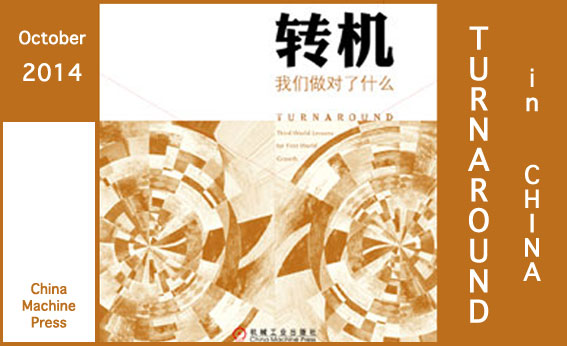26 Oct 2014 — How do you say “Turnaround” in Chinese? (Answer: Huízhuǎn) After months of biting my tongue, I’m pleased to finally announce that the Mandarin edition of Turnaround: Third World Lessons for First World Growth, has been published by China Machine Press. You can see Turnaround’s product page on dangdang.com.
The transformation of China’s economy during the past few decades, with millions of workers moving from fields to factories, is now the stuff of economic legend. The World Bank estimates that between 1980 and 2007, the Chinese economy lifted more than half a billion people out of poverty, and there is no doubt that the country’s rapid growth has reshaped the global economy as well.
Turnaround is about emerging nations more broadly (and what they can teach or re-teach advanced countries about economic discipline and prosperity), but Chapter Four devotes a bit of extra space to China. An excerpt from the section called “Catch Me if You Can” (beginning on p. 63 in the English language edition), explains the catch-up dynamic that helped create the modern manufacturing powerhouse China represents today:
In the framework of catch-up economics, China attained record rates of economic expansion because it managed to increase the growth rate of all three factors of production. It brought enormous quantities of people out of inactivity and underemployment in rural areas into gainful and more productive employment in the cities. China also promoted rapid rates of capital accumulation by permitting entrepreneurs to start their own businesses and keep the profits. Yet as important as capital and labor are for catch-up growth, ideas are the most vital input. Ideas range from new technologies–tractors instead of hoes, drip irrigation instead of buckets–to policies that provide incentives to employ both capital and labor more productively. By improving the productivity of existing resources, better ideas cause a country’s output of goods and services to expand even if its stock of capital and labor do not. The Chinese government increased the growth rate of ideas by “importing” policies that substituted many elements of a market economy for the elements of state planning. As investment became more profitable, foreign firms entered China, bringing with them still more new ideas–not about policy, but about things like supply chains, marketing, distribution, and sales.
With a seemingly unlimited supply of labor driving up productivity, plus new policies that encouraged capital accumulation and investment, a virtuous cycle of profitability took hold in China that allowed employment and income levels to go up and the country’s GDP to expand.
Yet it is unclear how long the current rate of growth in China can or will continue. Recent news headlines, including today’s Chinese Century article in The Upshot, convey more hesitation if not outright pessimism regarding China’s longer-term growth-rates. Certainly there is room for debate: future rates of growth could fall for reasons ranging from the simple arc of economic history (see The Upshot link above) to the reaching of a tipping point in China’s labor supply. In keeping with the themes of Turnaround, one might also imagine the effect on growth of any future shift in the country’s economic policies, particularly if brought about by rhetoric that is hostile to capital (think Picketty in the West) or that stems from resentment over matters of global economic coordination or trade.
This week, however, as I arrive in China for New York University’s Leadership Conference and, simultaneously, the incredible opportunity to launch in person the Chinese edition of my book, I am feeling optimistic and intend to focus on the positive lessons that China and Turnaround have to offer for all nations hoping to increase prosperity for future generations.
Book Events in China
On Monday afternoon, October 27, I am honored to give the first in a series of talks that are part of NYU Shanghai‘s Pudong Forum on Economics, Business, and Finance. Q & A session and book signing to follow the talk.
On Thursday evening, October 30, China Machine Press will hold its book launch in Beijing, where I will give a talk titled: “East Meets West: Economic Reform and Win-Win Outcomes for Global Growth” at BiMBA, National School of Development at Peking University.
